DESPITE increasingly tough restrictions in parts of Greater Sydney, the number of COVID-19 cases has trended steadily upwards over recent weeks. Of particular concern is that the number of new cases who were infectious in the community remains high; primarily for this reason Premier Gladys Berejiklian warned (rightly) over 2 weeks ago that “things are going to get worse before they get better”.
At the time of writing, it has been over 6 weeks since Sydney’s outbreak began. For most of this time, Sydneysiders have been subject to “stay at home” orders. Another 4-week period of lockdown was announced on 28 July, and with the current trajectory in cases, many saw easing of restrictions at that time as optimistic. Lockdown fatigue is becoming widespread and debilitating, and everybody in Australia is with Sydneysiders in hoping that outbreak will be over as soon as possible.
We appreciate that there has been an abundance of well-meaning but sometimes conflicting advice offered to the NSW Government and Sydneysiders. At the risk of adding to that, we want to offer what we believe are valuable observations and projections based on a detailed examination of Melbourne’s own outbreaks and lockdowns.
The Burnet Institute undertook detailed analysis of what did and didn’t work in Melbourne’s second COVID-19 outbreak in 2020. The data were used to calibrate detailed models (MACROMOD and COVASIM) that proved highly accurate in predicting the impact of various COVID-19 countermeasures, such as masks, and the timely release of restrictions. In this current work we fed data from Sydney into MACROMOD with the following results.
Controls introduced to date have restricted the epidemic
Despite the highly infectious nature of the Delta variant, the controls introduced to date, with effective contact tracing that makes use of new technology such as QR codes that was not available for the Melbourne second wave, have made an important impact. The record numbers of people in Sydney being tested daily is also important.
Using MACROMOD, we estimate that without the progressive introduction of restrictions starting on 26 June, including stay-at-home orders, further restrictions on 9 July and the closure of non-essential retail on 18 July, Sydney would have recorded approximately 1000 cases per day by now (29 July). We calculate that the restrictions implemented so far have avoided 4000 cases, over and above the many prevented by contract tracing and subsequent isolation (Fig. 1).
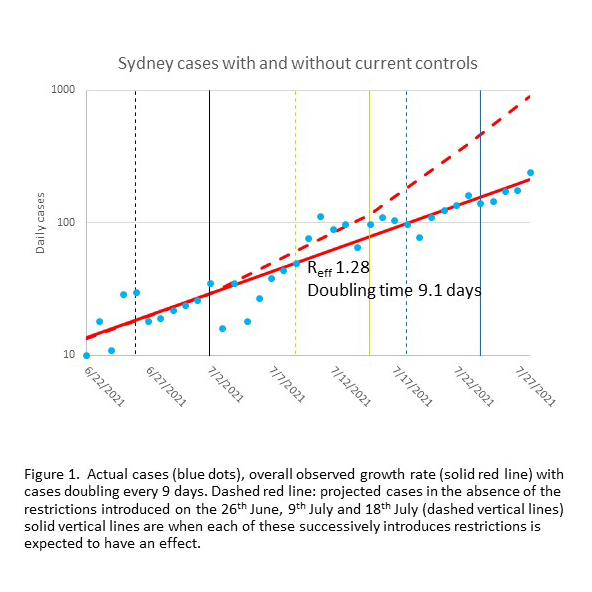
Despite the epidemic slowing, case numbers are still going up
Over the past 6 weeks, cases have doubled every 9 days on average (Figure 2).
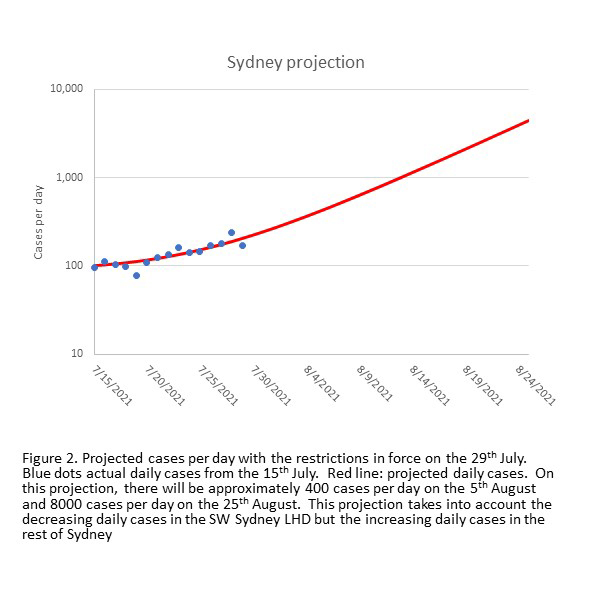
Presumably, the impact of toughened restrictions has been balanced by the epidemic spreading into new social groups, and contact tracers’ growing task to stay on top of infections and the number of people in the community while infectious. When we ran MACROMOD using trends in individual Local Health Authorities, it predicted that by this Friday, 5 August, Sydney will record about 570 cases per day. This is the result of stable or falling daily cases in south west Sydney Local Health District (LHD) being exceeded by rising cases elsewhere. It takes about a week before new controls have an effect, so we don’t expect new restrictions announced on 30 July to kick in until at least 7 August.
Furthermore, unless new controls introduced on 28 and 30 July or in the future (eg. LGAs that develop large case numbers are included in the tighter controls) have a major impact, our model projects that Sydney will have about 7700 cases per day 4 weeks from now.
Strong local suppression is being achieved, but seeding is still occurring
This epidemic started in the eastern suburbs, then south east Sydney, then spread through Greater Sydney from Wollongong in the south to the Central Coast in the north. The burden has been high in south west Sydney, particularly in Fairfield. As a consequence, south west Sydney had been subject to tighter restrictions than the rest of Sydney, as well the Government providing resources for significant community engagement and support.
Evidence suggests these measures have worked: an upward trend in daily cases in south west Sydney reversed on 15 July, exactly when we expected the restrictions introduced on 9 July would take effect (Fig 3a).
However, cases in the rest of Sydney did not follow this pattern (Fig 3b).
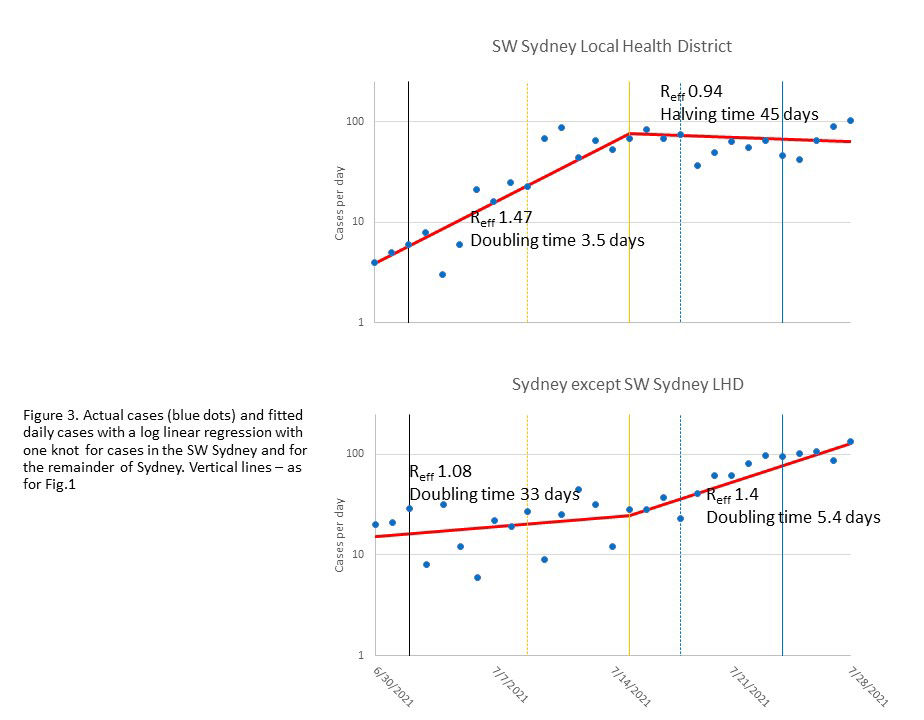
Although the number of cases is still lower outside south west Sydney, daily cases in the rest of Sydney are now increasing at about the same rate as happened initially in Fairfield – doubling every 4–5 days. It is not clear why the rates have accelerated, but this increase is statistically significant (p = 0.02). The NSW Government recognised the increasing problem outside the south west Sydney LHD, and has progressively imposed stringent restrictions on more local government areas (LGAs), such as Georges River, Campbelltown and Parramatta.
However, the adjacent LGAs of Burwood and Strathfield (west of the CBD) had higher incidences per capita during 19–26 July than either Parramatta and Campbelltown (Table 1), and Bayside (SW of Sydney Airport) had a higher rate than the adjacent LGA of Georges River, but have not yet been included in the more stringent restrictions.
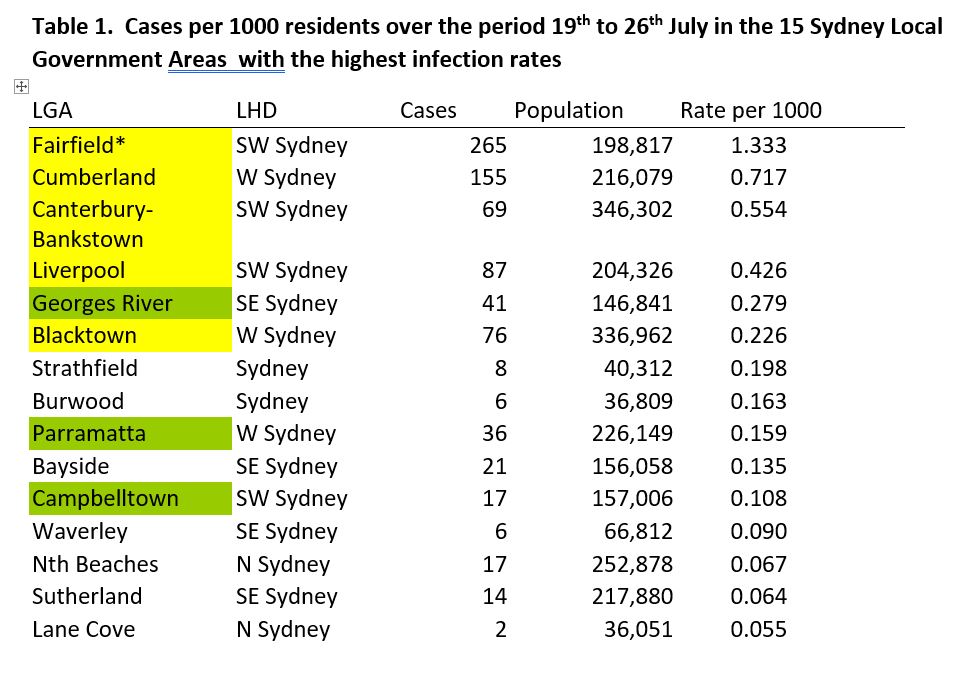
LGA in yellow: part of most restricted LGA as of 18 July. LGA in Green added 29th July Population based on 2016 census
Which NSW locality is going to be hit next in this current “whack a mole” situation? After all, in mid-June, residents of south west Sydney, along with the rest of Australia, probably thought that this outbreak was just a Bondi problem.
The reality is that no one is safe until everyone is safe. Every positive case, no matter in which LGA, takes testing and contact tracing resources and has the potential to trigger new outbreaks. A highly mobile population means new outbreaks could occur anywhere in Sydney or NSW or across Australia, as recent exports of disease to Melbourne and Brisbane show.
What needs to happen next?
We recommend implementing more consistent stringent restrictions, akin to those announced for the 8 high-priority LGAs, uniformly across Sydney. Not only is this the equitable approach, but epidemiologically sound.
Importantly, our modelling shows even with these enhanced restrictions it is going to take until the end of September to reduce case numbers to below a 7-day average of five per day. We sincerely hope we are wrong, and the daily case load drops much faster.
Two things are likely to significantly reduce the time to the end of lockdown: first, that everyone follows the current restrictions in place and where necessary receive the appropriate supports to help them do so. Second, that people get vaccinated as soon as a vaccine is available. There is a lot at stake: saving lives, the health and economic well-being of the residents of Sydney and NSW and diminishing the threat of SARS-CoV-19 export to the rest of the Australian population.
Professor Allan Saul is Senior Principal Research Fellow (Honorary) at the Burnet Institute.
Professor Brendan Crabb AC is Director and CEO of the Burnet Institute.
Dr Campbell Aitken is a Research Fellow at the Burnet Institute.
Professor Margaret Hellard AM is Deputy Director (Programs) at the Burnet Institute.
The authors would like to acknowledge the contributions of Professor Mark Stoove and Dr Mike Toole.
The statements or opinions expressed in this article reflect the views of the authors and do not represent the official policy of the AMA, the MJA or InSight+ unless so stated.

 more_vert
more_vert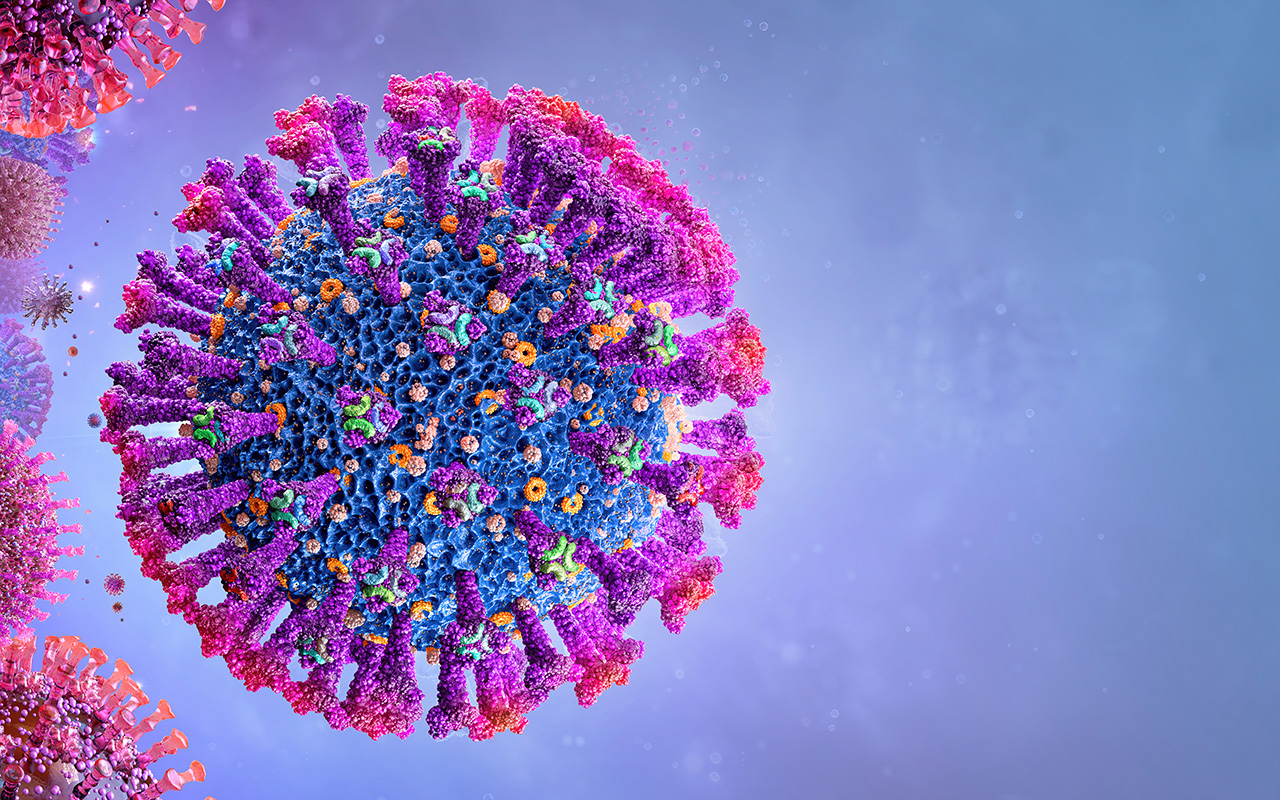
Last week,at the top of the table of cases per million of Covid is the Most vaccinated country in the world,Israel.
Perhaps the Burnet might go back to their books.
It is not about “cases”.It is about hospitalisations and deaths.
Your prediction was for “Friday 5 August” (which does not exist) NSW would see 570 cases. In fact, August 5 saw 268 and August 6 saw 291 cases.
Given this, would you like to revise your estimate of 7,700 cases a day by month’s end?
Likewise with “4,000 avoided cases”?
Dear Burnet Institute
I believe that 5 August 2021 is a Thursday, not a Friday. I have checked this with multiple sources and they all agree with me. Australia uses the Gregorian calendar, but I am not sure which calendar is used by the Burnet.
Could you please clarify on which day — Thursday 5 August 2021 or Friday 6 August 2021 — your model predicts 570 cases in NSW?
I cannot understand why they are not using easy comfortable home use rapid antigen testing to encourage sensible people to home isolate and redistribute unaffected family members; the modelling has been demonstrated since July 2020 (Paltiel JAMA Open). Slovakia did it, Liverpool dropped infections by 20%
When are they going to make mask and face shields mandatory in schools for ALL students and staff. Primary students are unvaccinated and have parents who are usually less than 40 years of age so are less likely to be vaccinated. This is dangerous with Delta. School students overseas wear masks.
Treatments to stop the “storm” of the Delta and tablets to take early to stop it becoming a critical situation need to be reviewed by our Government. We require a multi pronged approach, not just vacines. In Sputnik article on internet. They have vacines Spurnik Astra V which vacinates you AND stops you from passing it on. Only vaccine that does this apparently.
We all talk about vaccinations and length and damage of lockdowns and the unfortunate deaths and serious illness covid, particularly this delta variant, has caused but we are not discussing the main root of the problem and that is return overseas travellers directed to do their 14 day isolation in densely populated capital state city motels. That is your reason why outbreaks start. The recent Queensland incident is proof of this. The Prime Minister needs to use logic and ensure these returning Australian citizens are safety out of range of the Australian public majority and placed on Christmas Island or a similar facility. You might assume they are unable to spread covid locked away inside a Sydney motel but think again. The cleaners, security and front desk staff don’t isolate with them and get to go home after their shift ends. The deadly chain of events commences. Maybe even 21 days is required to safeguard the major population. Scott Morrison did this with the 600 Australians from China when it first started in 2020 and makes sense now. All the same vaccination is a strong weapon we can all benefit from.
There is no doubt vaccination is the key to becoming ‘COVID’ free. The hesitancy towards vaccination has shown just how critical the ‘race’ really was. Federal leadership was at fault – no doubt. Those over 50 years old have no excuse to not be fully vaccinated at this point in time. The wait for a ‘better’ vaccine was ill-foundered, but supported by poor journalism and academic vested interests. It has bitten us on the backside with force.
Those who are in the queue – the over 50s and have missed their shot, should be pushed to the back of the line. They had their chance, left it aside, now they slow the queue for the under 40s – the mobile workforce in desperate need for protection. The over 50s can get back in the queue when the rest are done and vaccines are available.
A structured process was put in place. Too many thought they had better ideas on how it should be done. WRONG.
For the record, I am an over 50 year old. Fully vaccinated for almost a month, and yes, it was a very simple task, especially with the wide availability of vaccine that was at hand at the Olympic Park Vaccination Centers. Absolutely no excuse. For now, protect the under 40s, the 50 pluses can stay locked up till the end.
Im in the Cumberland area and me and my family really want to get the Pfizer, when will this happen??and where?
The management of this crisis is way off track ! Look at Canada, Israel, Seychelles as a start …all have high vaccination rates but are now starting to see COVID variants increase and vaccine efficiency decline. This government is not looking to find the very best advice when it comes to eradicating the virus. There are highly qualified experts in the areas of virology and infectious diseases who have said that mass vaccination with leaky COVID 19 vaccines will only lead to more infectious variants. So this government and the health authorities could be creating a Petri dish for the virus to mutate and develop strains which bypass the current vaccines and our own natural immunity may not be able to combat. This is a complex problem and it is becoming apparent that getting 70% of the population vaccinated by November and locking everything down is not the answer.
I have emailed the CDGN who are responsible for gathering all information on variants of concern and analysing and presenting courses of action to government and health authorities.. no response !!!!
The delta variant is difficult to get back in the box
The only way is very very tough lockdown for at least all of Sydney with curfews
A ring of steel around Sydney is very important otherwise the is variant will slip out into the surrounding areas .
Vaccinations should be incentivised for example $100 per shot or a monthly lottery for first jabs say $5M
We need to get people to take any vaccine that is available
It’s a long time to wait but not choice is available as you can’t live with Covid you only die with it
While Gladys deflects on a very true need “get vaccinated” , it is really not what is going on as while vaccination is a necessity, tighter and more consistent and clear restrictions are what is needed immediately.
Is Gladys behaving like this to save face, to use up stock piles of A-Z as whatever it is, it is not health advice and Kerry Chant is complicit.
Avoidable deaths and illness will occur from not only the delta virus but now also from the AZ vaccine that risk/benefit needs to be used by most of those under 60.
Sydneysiders are kidding themselves that a 4wk lockdown will get them any closer to some kind of freedom. Gladys and Kerrie Chant are more comfortable with deaths than they are with looking like they are doing what labor states like Vic did to get the situation under control. Vic took a state wide approach with consistency for all which worked a treat. It’s not too late but the door is closing fast. Strict lockdown for all is needed as even a vax rate of 70% which will take 3 months, will not alleviate the hospital overwhelm and deaths, at least until Summer.
Demand best practice lockdown protocols as ring fencing Delta strain has shown worldwide to be a failed approach.
There is no return to normal until the virus is under control by vaccination, until that happens.. let Burnett advice prevail, their advise is also the most economically sensible
There is an obvious mismatch between the numbers in the western suburbs and elsewhere. Common sense should prevail with tighter lockdown where indicated and partial opening up in low incidence LGAs. Of course this would provoke a political storm which our leaders are not brave enough to weather.
Dear Saul and Colleagues,
Thank you for your detailed epidemiological modelling. It is easy to advocate for lockdowns when focusing solely on daily COVID case numbers, without balancing these against the wider economic and social costs. These are important and substantial.
For example: Federal government debt alone has increased by $600 billion which could have funded 600 new hospitals, 100 new international airports, 10 Brisbane-to-Melbourne high speed train tracks. This does not even take into account the wider economic and societal costs of lockdowns. Servicing this debt at 1% will cost our nation $6 billion per annum, equivalent to 6 new hospitals every year. Is it equitable to constantly disrupt our children’s education when it is they will shoulder this enormous financial responsibility their entire working lives?
Thus the policy de-facto of elimination is neither: achievable, sustainable, affordable nor equitable. SARS-CoV-2 is now endemic, the delta-strain is highly transmissible, vaccines do not completely prevent transmission and even IF vaccination rates of 80% are achieved there will be 4 million susceptible Australian adults. Meaning, there will be daily cases, hospitalisations and deaths. Unless of course we keep international and domestic borders closed indefinitely.
We must abandon this policy of elimination, restore Australians’ fundamental human rights, focus on mass vaccinations, increasing hospital capacity, while enacting reasonable suppression/prevention measures to maximise civil freedoms whilst minimising casualties.
Sincerely,
I do find the situation in Sydney very concerning, I have family in Sydney and I worry for them also to me it places the whole of Australia at risk.
I do not believe the decisions being made by Gladys Berejiklian are based on the Health Advice but are politically motivated – she is out of her depth. People will die because she is not doing the right thing.
My son contracted COVID in December 2020 while in Medellin, Columbia and was very ill. He is 28 years old and prior to contracting COVID was a reasonably healthy fit young man. Since returning to Australia in January he has continued to be affected. Long COVID, Hyperthyroidism, Chest Pain, Fatigue and periods of confusion. We will not understand the long-term impact of this Sydney outbreak until after it is over.
Good to see someone of you are doing some analysis and publishing. Agree with the findings and the suggestion. Also, give whatever vaccine available to what the people are happy to receive. Yes there is a shortage of Pfizer-BioNTech, but inoculating that one person is better than turning him/ her back without the dose.
AMA and Government health advisers should start talking to each other and speak the same language. I am sure AMA will have more experienced epidemiologist in their membership than the health department. This is purely my opinion as an observer.